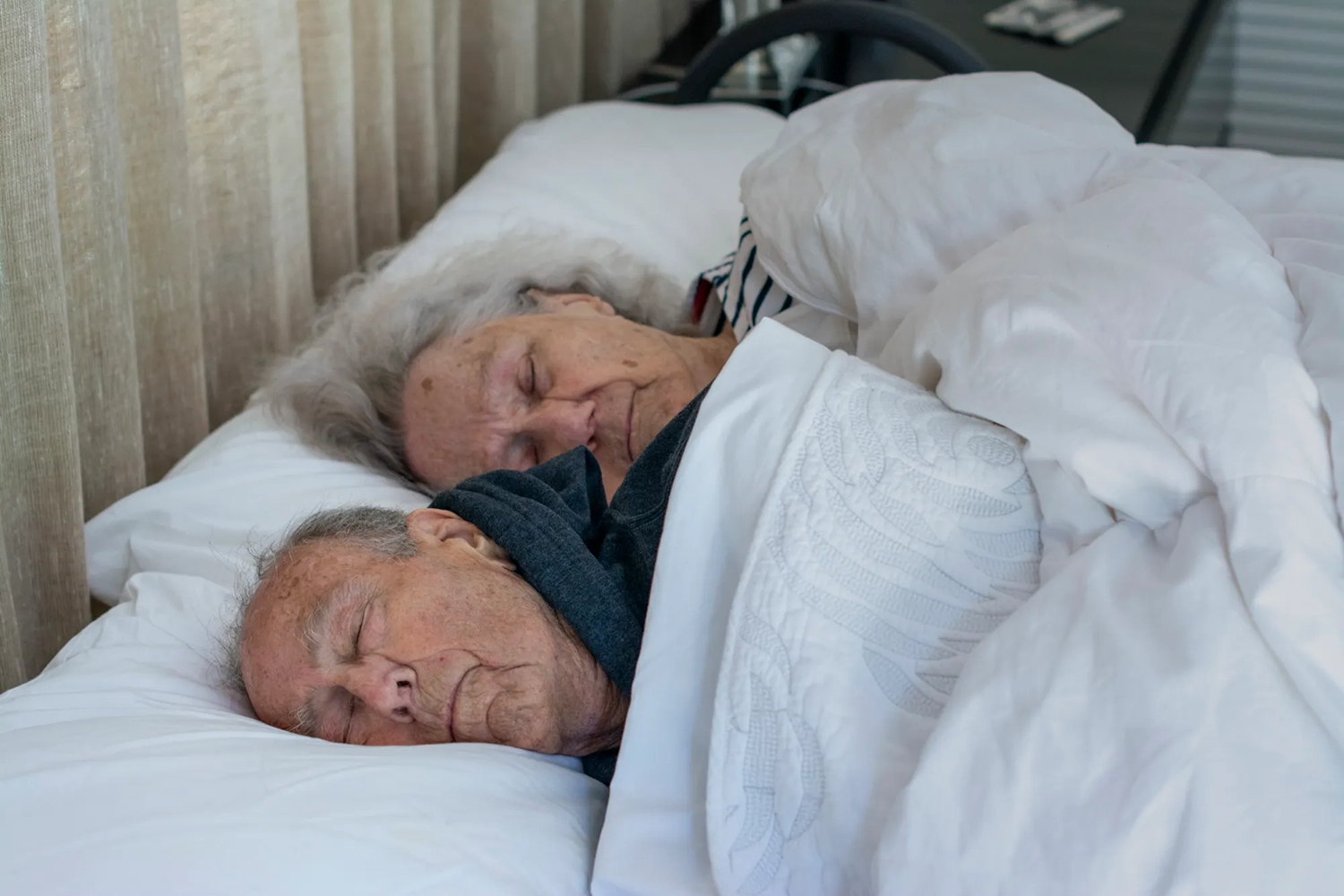
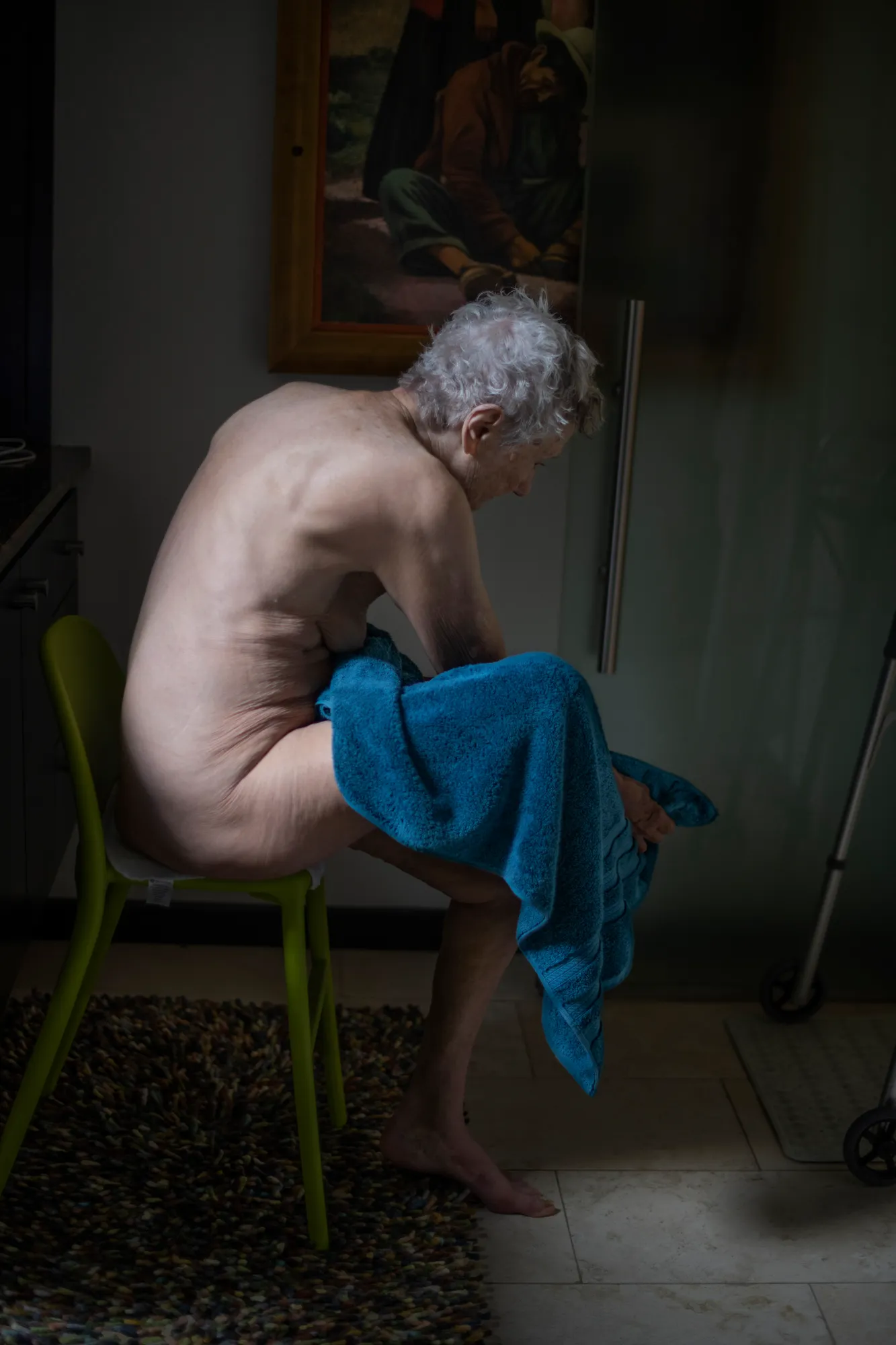
Bob and Mary, Becky Wilkes’s parents, lived with her in her single-story home for a year. As Covid ravaged the world beyond their door, they built a world of their own. She spent her days making meals for them; they took naps together, hand in hand. They joined each other for walks along the driveway, basked in the afternoon sun, and completed crossword puzzles.
Bob and Mary understood that this was the final chapter of their lives together. “I remember telling them that their story needed to be documented,” their daughter says. “My parents were never shy around a camera, and they instantly agreed.”
It was the winter of 2020. With Covid restrictions preventing Wilkes from taking part in her parents’ care, she moved them into her house. Due to their health and lockdowns, her mother and father had briefly been separated, with her father in hospice and her mother living independently. At their daughter’s home, they could be together every day. She witnessed their love story up close, and she realized her own part in that story.
The artist’s father passed away suddenly in January 2021, approximately one year after the move. That was two years ago today. Her mother followed two months later. In the time since, Wilkes has held onto their belongings and many of the ephemeral, mundane objects from their lives together, including pill bottles and doctor’s bills. But perhaps more than anything, she’s held fast to the photographs they made–the three of them.
“I grieve over the images where I over or under-exposed the shot,” she says now. “There is one photo of my daddy sitting in the sunlight where detail is lost in the highlights. It strikes me that these are pieces of my daddy that I lost.” Though photographs can never contain every detail she carries with her, Wilkes’s parents left her with thousands upon thousands of pictures, each holding traces of both their love for each other and their love for her.
“If the door was open, I was free to photograph them,” the photographer tells me. “They almost never closed the door.” We asked her to tell us more about Till Death Do Us Part, a photographic love letter to her parents.
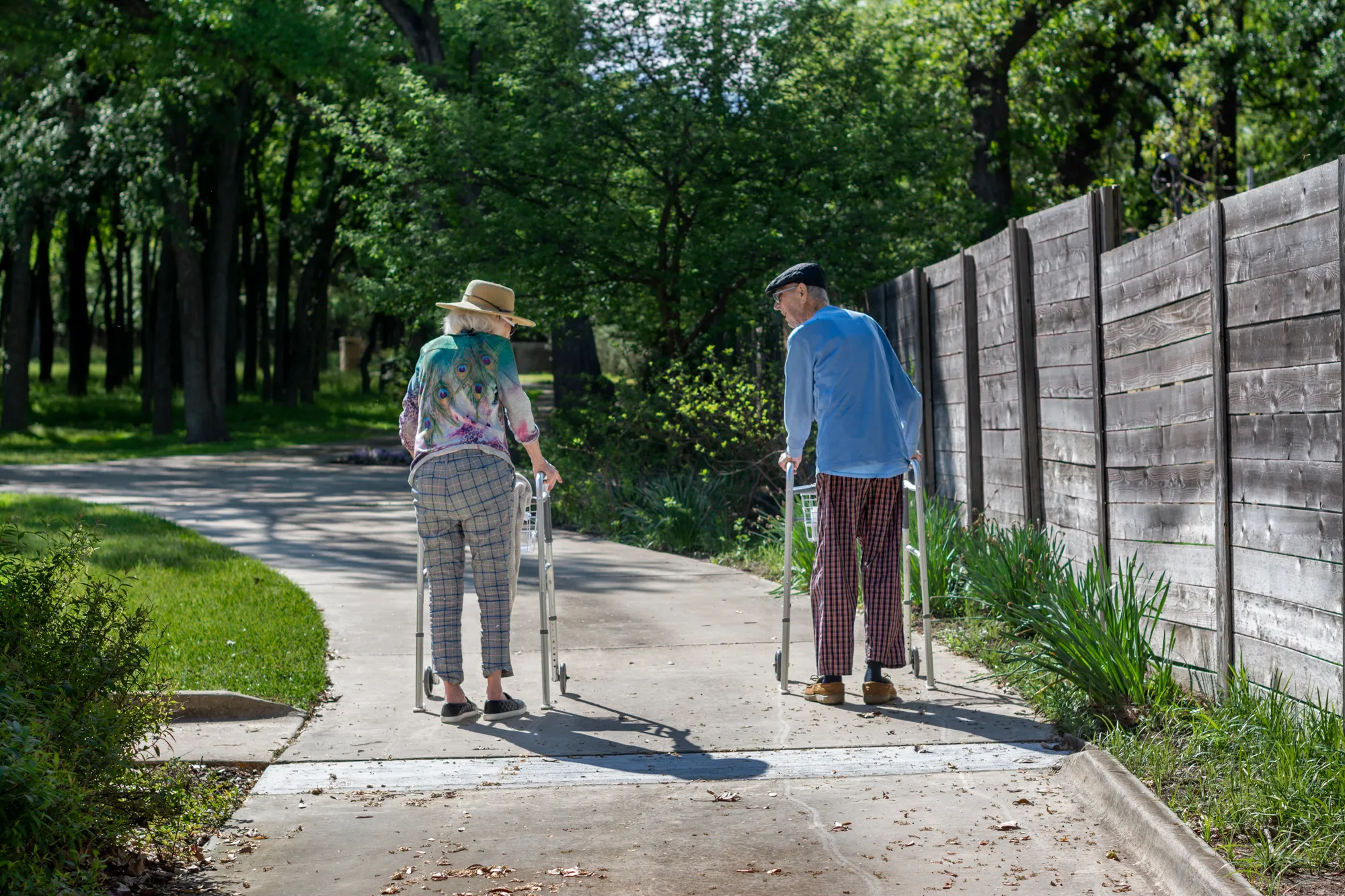
Might you tell us a bit about your parents and their love story? How did they meet?
“Daddy was born March 7th, 1931, in the Heights area of Houston, TX, to a devout baptist mother and a stern Catholic father. Daddy, like his father, graduated from St Thomas Catholic High School. Mom was born September 3rd, also in 1931, about a mile away from Daddy. Her mother, of Polish descent, was raised on a cotton farm outside of Anderson, TX, and her father, a recent immigrant from Croatia, served his patrons in his downtown cafe.
“Dad pursued mom after meeting her at a CYO (Catholic Youth Organization) function. She played hard to get, but dad was relentless, following her with his clean shiny car, always trying to offer her rides. They dated for a few years, and Daddy proposed. She said yes but on the condition that he could locate the jeweler that had the ring she had selected. Daddy said it felt like he searched every jeweler in Houston before locating it the day before he was to ship out to Korea.
“Daddy always thought mom was the catch he spent his nights dreaming of, while mom struggled to believe that anyone would ever want her as a catch.”
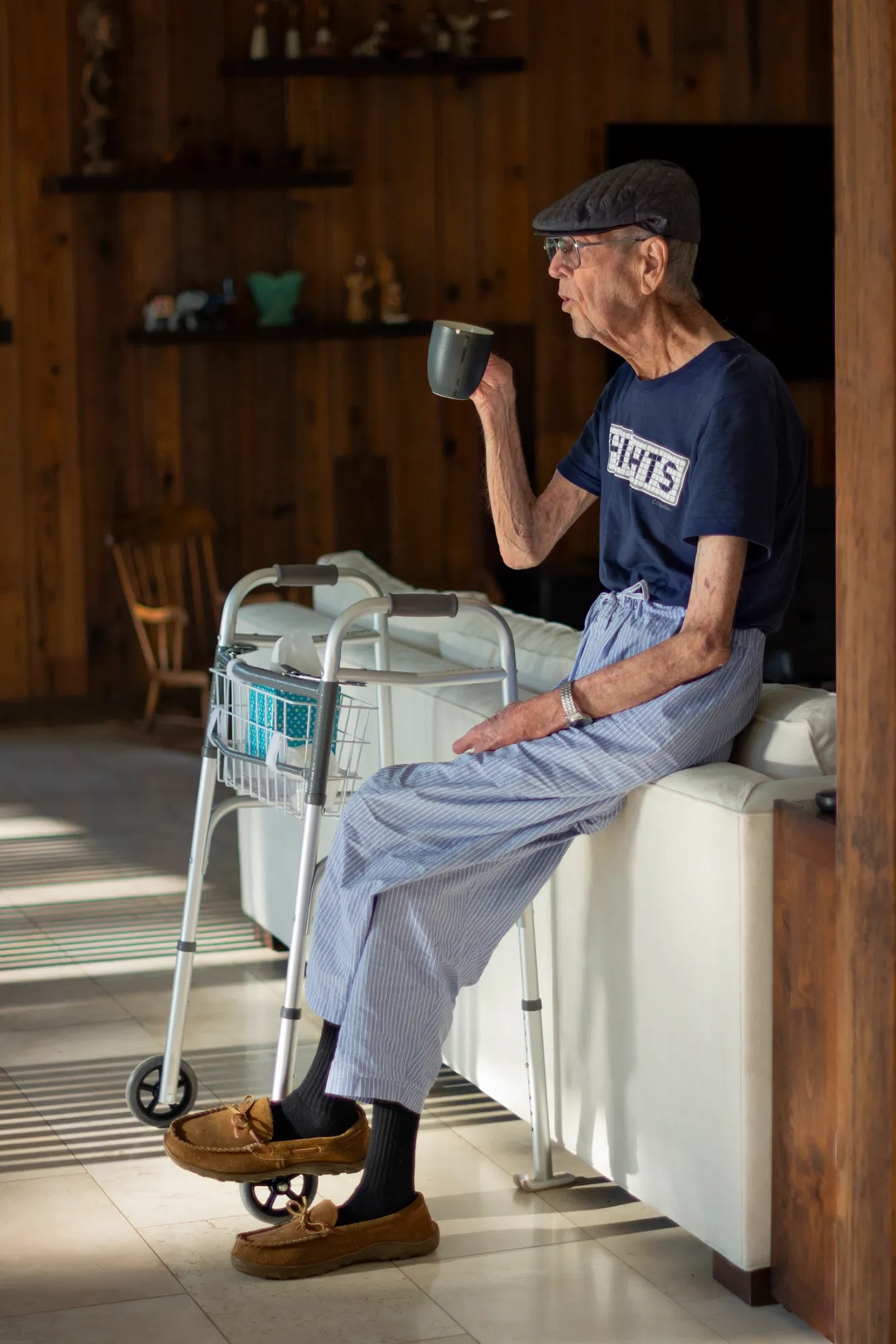
What are some of your earliest memories of your parents and their relationship?
“Mom and dad were always very firmly rooted in family, church, and neighborhood, and those connections endured throughout their lives. Daddy worked for Southwestern Bell Telephone Company, starting out climbing poles as an installer and eventually retired in management. Mom started college in her early 30s with four small children and graduated with a master’s in education.
“Mom was extremely frugal and could make the rare single candy bar stretch six ways. We often made our own clothing, shopping for discount fabric at moonlight madness sales. Despite both parents working, we always ate dinner together as a family, watched a bit of TV together in the evening, and traveled regularly on family vacations in a tiny trailer to the national parks.
“They were always good sports about dressing up for the many costume parties they attended with their neighbors. For 20 years, they volunteered at their local hospital, mom in the gift shop and dad pushing gurneys for the ER. They loved their church choirs, bible studies, and exercising at the local YMCA. They cherished their extended families, attending celebrations, weddings, funerals, and formal and casual reunions.”
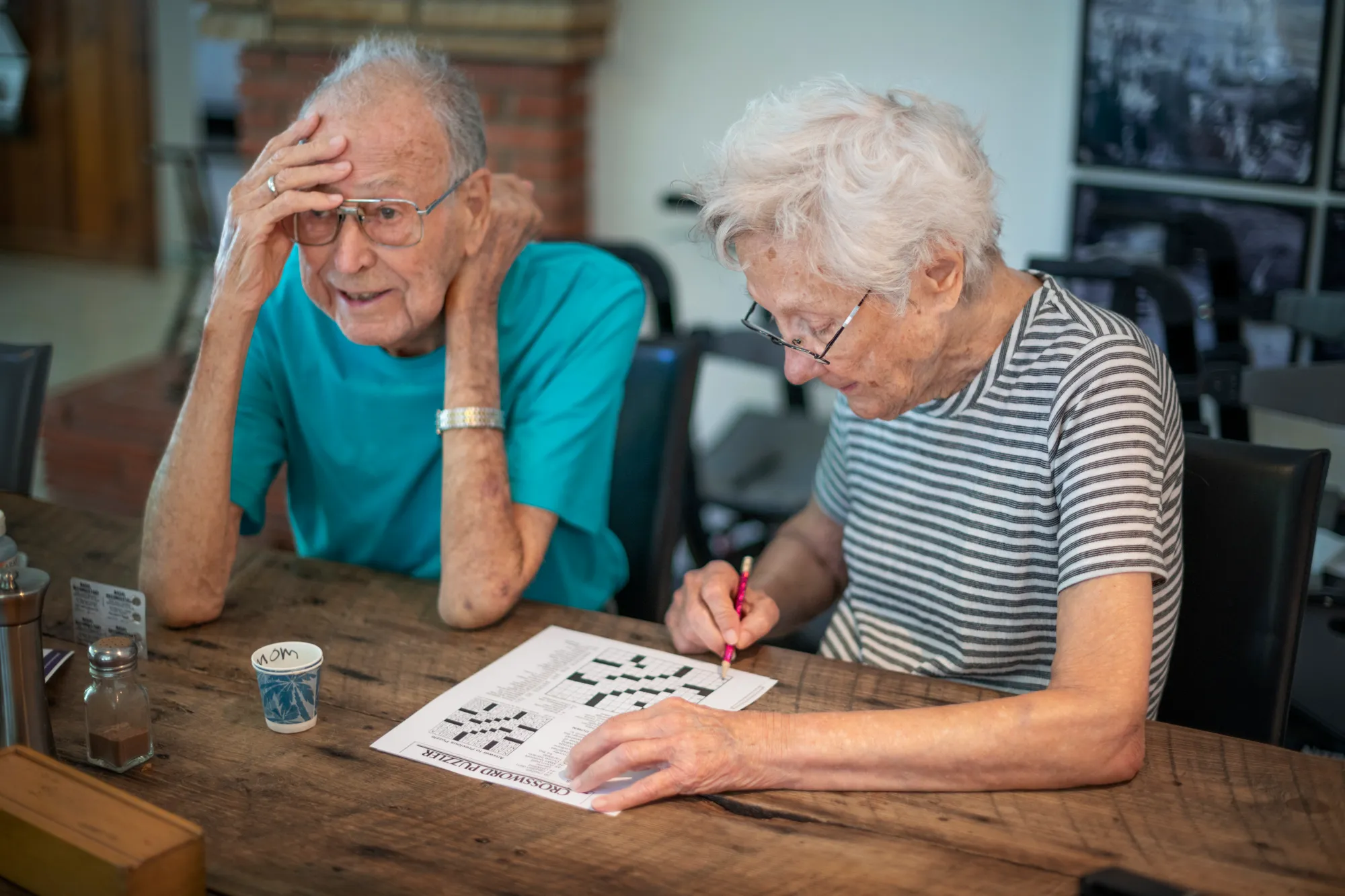
Can you tell us a bit more about the decision to move your parents into your home?
“In November 2019, after debating the decision for several years, my parents moved from their home into a senior facility that offered them the option of progressive care. Two months later, in January 2020, daddy was admitted to the hospital with congestive heart failure. The day before he was to be released, mom had a stroke.
“They spent three weeks in adjoining rehab rooms before mom was released to live independently in their apartment and daddy was placed on hospice with skilled nursing in the distant wing of the same building. It was a challenge for my mother dress herself, much less visit daddy without assistance. For the next month, my siblings and I took shifts; staying with mom, managing her recovery, and witnessing daddy’s decline.
“Covid restrictions put in place by the facility confined my mother to her apartment and denied my parents access to each other, as well as preventing us from assisting in their care. Almost immediately, I made a gut decision to change their living situation; two days later, my brother and sister arrived with them and a few of their belongings to live with my husband and me in Azle, TX.
“I felt capable of managing their care needs for the foreseeable future in our single-level home with ample room for walkers. My thought was that I could not prevent Covid from entering our home, but that at least they could be together for Daddy’s remaining days.
“Upon arrival, daddy weighed 106 pounds at 6’1” and could barely eat a meal without getting sick. Mom struggled to stand from a seated position, having lost much of her rehab progress after being isolated (due to the shutdown). It was touch and go for a few weeks, but nourished by food, care and supervision, they began a slow recovery. Naturally, I shared these moments with the family through regular texts, phone photos, and videos.
“My husband was initially skeptical about the decision but accepted my desire to provide this care for my parents. Within weeks, he confessed his admiration for my efforts and admitted that had I not made this choice, my father would have been dead.”
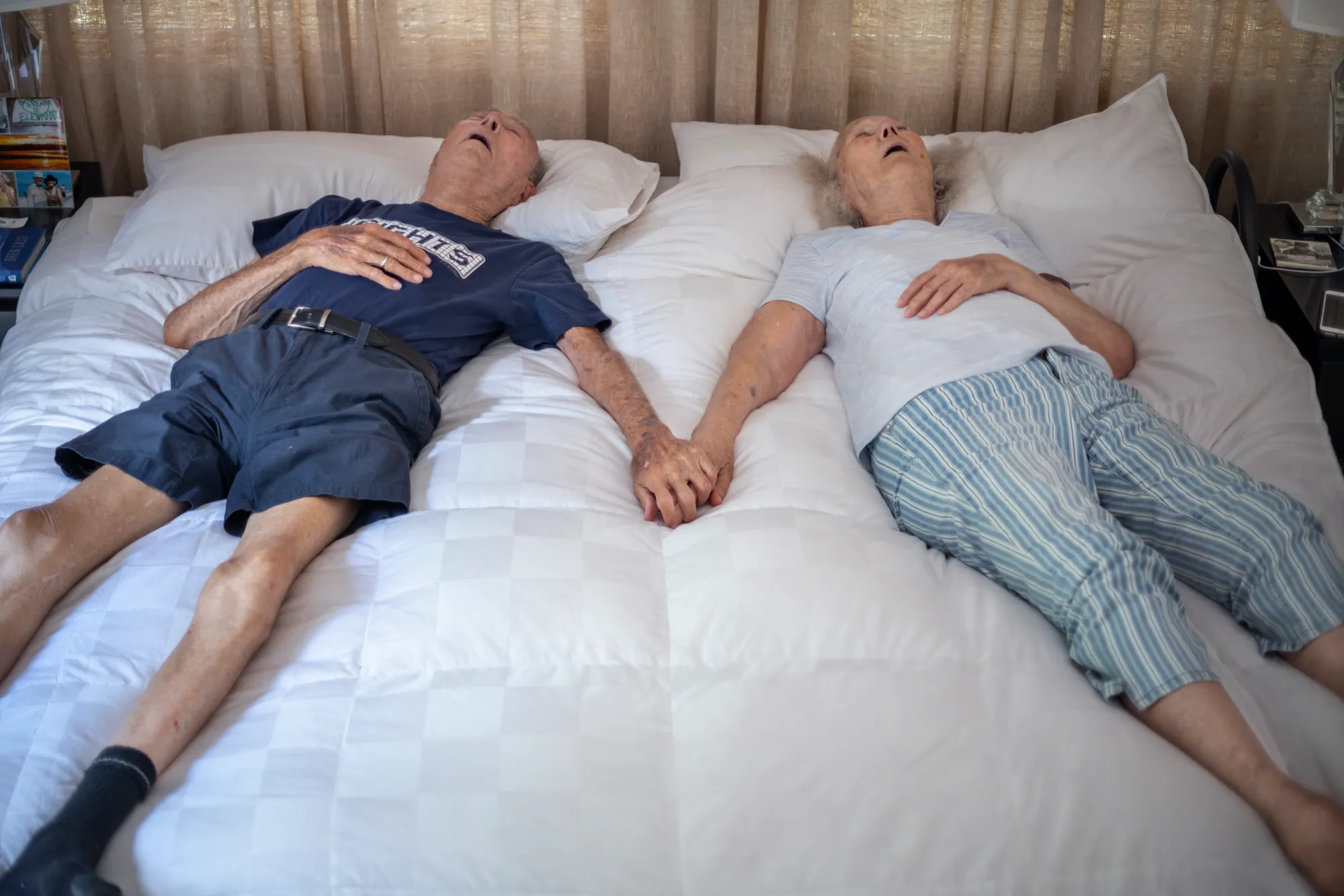
Did your parents get to see the pictures as you were making them?
“Several weeks after I began shooting, they saw the photo of mom standing before the shower, daddy whistled, and they both thought she was ‘pretty hot for an old woman.’ They were very cute about their reaction. I didn’t spend too much time showing them photos, as it was all I could do to transfer them to my computer during nap time and occasionally try to edit them. After daddy’s death, I shared many of the photos with my mother. It was a very tender moment; she was overwhelmed and declared it a very beautiful story.”
What did daily life look like for you and your parents during this time of living together? Did you have a routine?
“With the exception of their intense medical needs, caring for seniors is much like parenting; routines become critical, except they are slower, very much slower. I would usually rise before them, put on a pot of coffee, and set out a simple breakfast: usually cereal for dad and oatmeal for mom with their ever-changing pills. Showering and getting dressed could take an hour or more.
“They would sit and read or take short walks down the driveway, while I put lunch together. After lunch, we would play a short game, most commonly Dominos, as daddy’s memory loss made remembering new rules a challenge. Nap time followed, which often stretched several hours. Again, they would read or walk, do therapies, medical or physical, until dinner. Dominos followed, then they prepared for bed before our nightly TV time. The only time I assiduously reserved for myself was nap time. This was my time to further my art making, edit photographs, apply to shows, create new work, etc.
“I might have felt challenged by these routines had COVID not obliterated everything else in our lives. But the entire experience was joyful, powerful, awe-inspiring, and humbling. The ultimate sacrifice of self is probably the most rewarding aspect of living. While the rest of the world was isolated from so many of their loved ones, we shared daily laughter, difficulties, sadness, and all that life and aging bring us.”
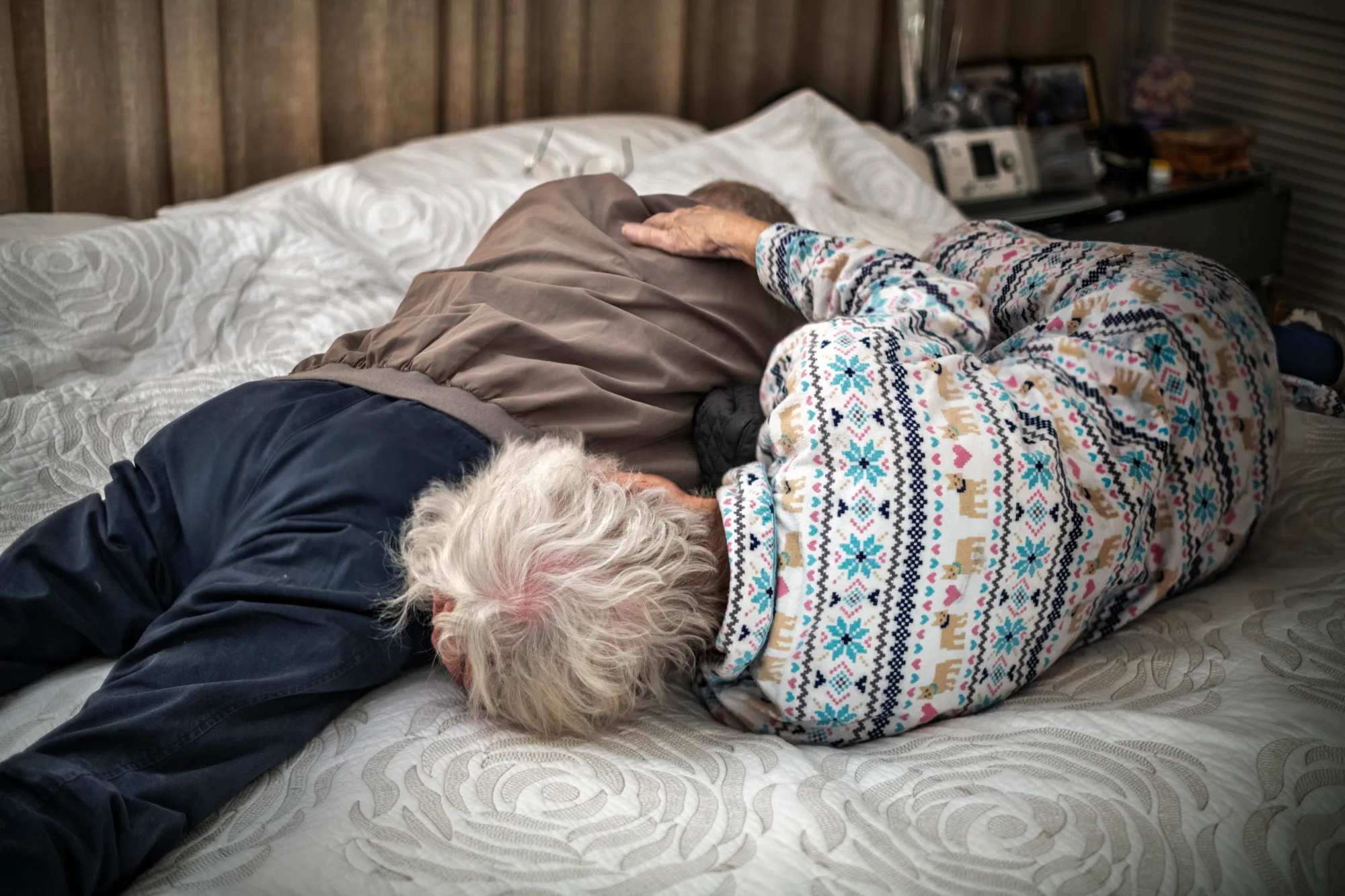
What did your daily life look like as a caregiver during this year?
“Daily, I was busy! I would often hear complaints of boredom during COVID and just laugh to myself. The routines for two seniors were enough to keep a person crazy busy, but I also juggled a calendar that was filled with doctor appointments, physical therapies, nurse visits, not to mention trips to purchase supplies and make meals.
“I am amazed at how quickly we pivoted to include them in our home and our routines. We were constantly rearranging furniture and space to allow easier access for them to move about; rolling up rugs, moving chairs that were easier for them to use, installing bars in their bathroom. I do think we all tried to be considerate of living together.
“Although I had been in regular and increasingly significant contact with my parents throughout their lives, nothing could have prepared me for the transformation that I was to witness, not only in their health and mental state, but also their relationship with each other and my relationship with them. I was consistently awed by their tenderness and close proximity to one another and the undeniable beauty of their aura. How could I not want to capture this?”
What is your most powerful memory from your time working on this project? Anything you’ll always hold onto?
“There are several. The actual experience of caring for my parents and extending their lives together will always be with me. Their grace to bravely face their own mortality and each other’s, especially at the very end of their lives, was awe-inspiring. Being entrusted with the life of another person is empowering yet humbling.
“Witnessing the transformation in my parents’ relationship with one another is another aspect of this experience that will endure. I can only imagine that when faced with the certainty of the imminent death of your life partner, the universe shifts and your priorities crystalize. My relationship with them also changed. Our prior personalities had often collided. There was a day, when mom remarked, ‘You know, you are really good at this,’ meaning navigating their many needs. For me, it felt like she was seeing me for who and what I could do for the very first time.
“When these images cause a person to take a moment to pause, it shatters me. Sharing the portfolio with certain specific persons, who see the person behind the camera and innately recognize the bigger picture, brings me to tears, and I don’t cry easily.”
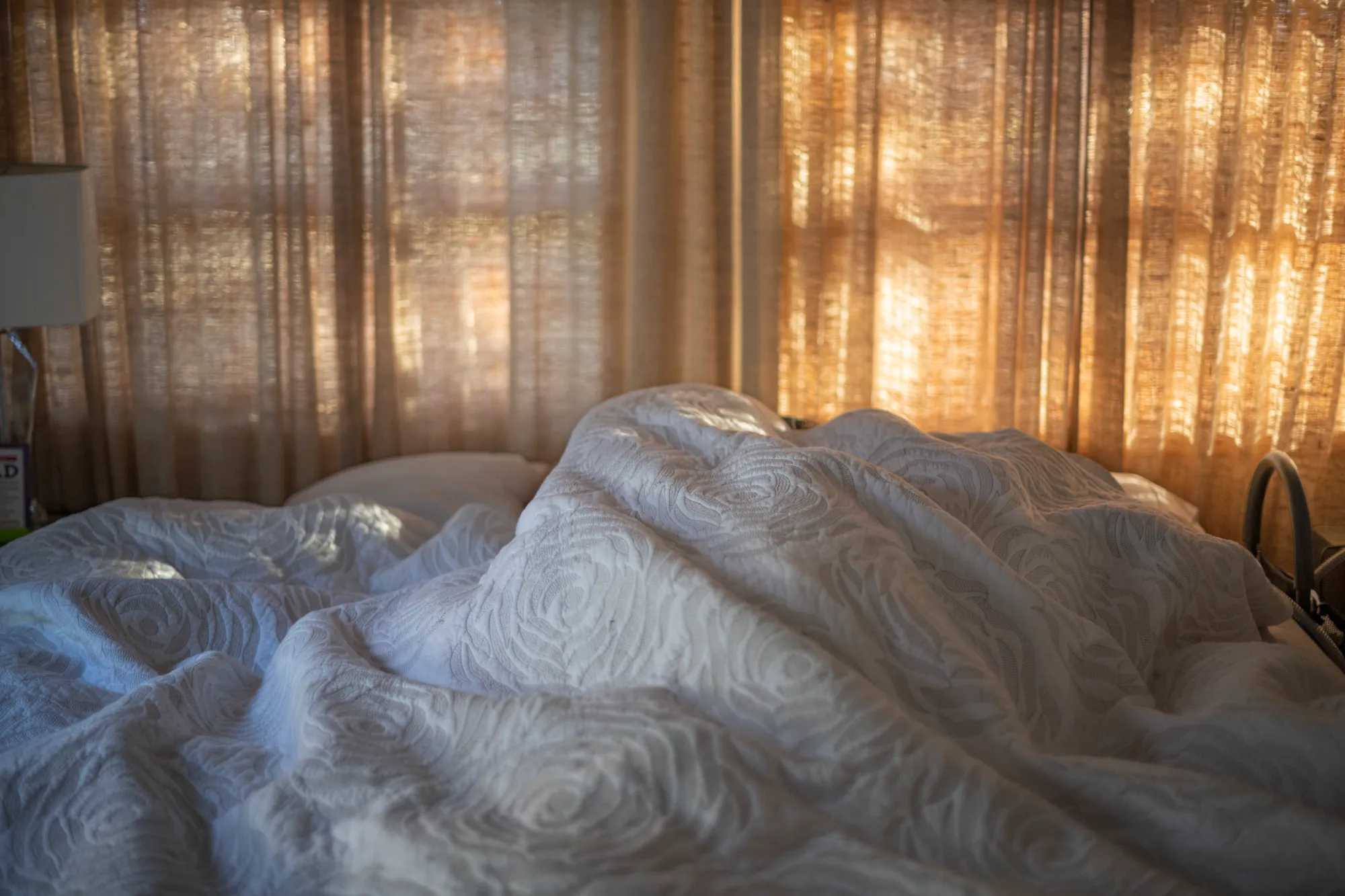
In what ways, if any, did these photographs influence how you navigated the grief of their deaths? Do you return to them often?
“The photographs were and are my grief experience. Editing them, curating them, trying to decide which ones are the most impactful is so very difficult for me. I am not often a confident photographer. When I ‘see’ the image that I want, I might take 30 or more images trying to ensure that I ‘get it right’ and in focus. After daddy’s death, I studied the details of each image as a secondary observer trying to decide which was one is the most evocative, sharpest focus. It’s hard; it’s churning. My stomach ached viewing them. As I sit and edit them, and it’s like they are dying again.
“I was given to opportunity to exhibit about 80 images in a beautiful gallery this summer. Editing, printing, and titling the photos had been a driving obsession for the year and a half since Mom and Daddy died. The show was beautifully curated with and by J. Sybylla Smith. It was an illuminating experience for me to see how she built this story; weaving the moments of intimacy, vulnerability, and pain. I finally had the opportunity to step back from my role as observer and to immerse myself in their story anew.
“Exhibiting these images publicly was cathartic. I had not anticipated the impact that I would have sharing this experience and witnessing the reaction of others to it. Using photographs rather than words, I was finally able to unburden myself of the story. Deinstalling the show was extremely difficult, as it felt like I was burying my parents for a second time.”
Are the image captions quotations from your parents?
“I am so happy you asked this question. Daddy had a repertoire of silly sayings, and mom was always coming at you out of left field. But she was also a deep thinker. About three to four months into our time together, I started keeping track of things they would say. Sadly, I never recorded them speaking. When I was preparing the images for exhibition, I spent hours with my sister, looking at the photos matching them with the appropriate titles. Some of the titles I knew the moment the image was taken. The morning after daddy’s failed hip surgery, mom took the snapshot of her that had been in daddy’s wallet for 50 years to the hospital with us. She tucked it in his hand and said, ‘Take Me With You.’ You can’t make that up.”
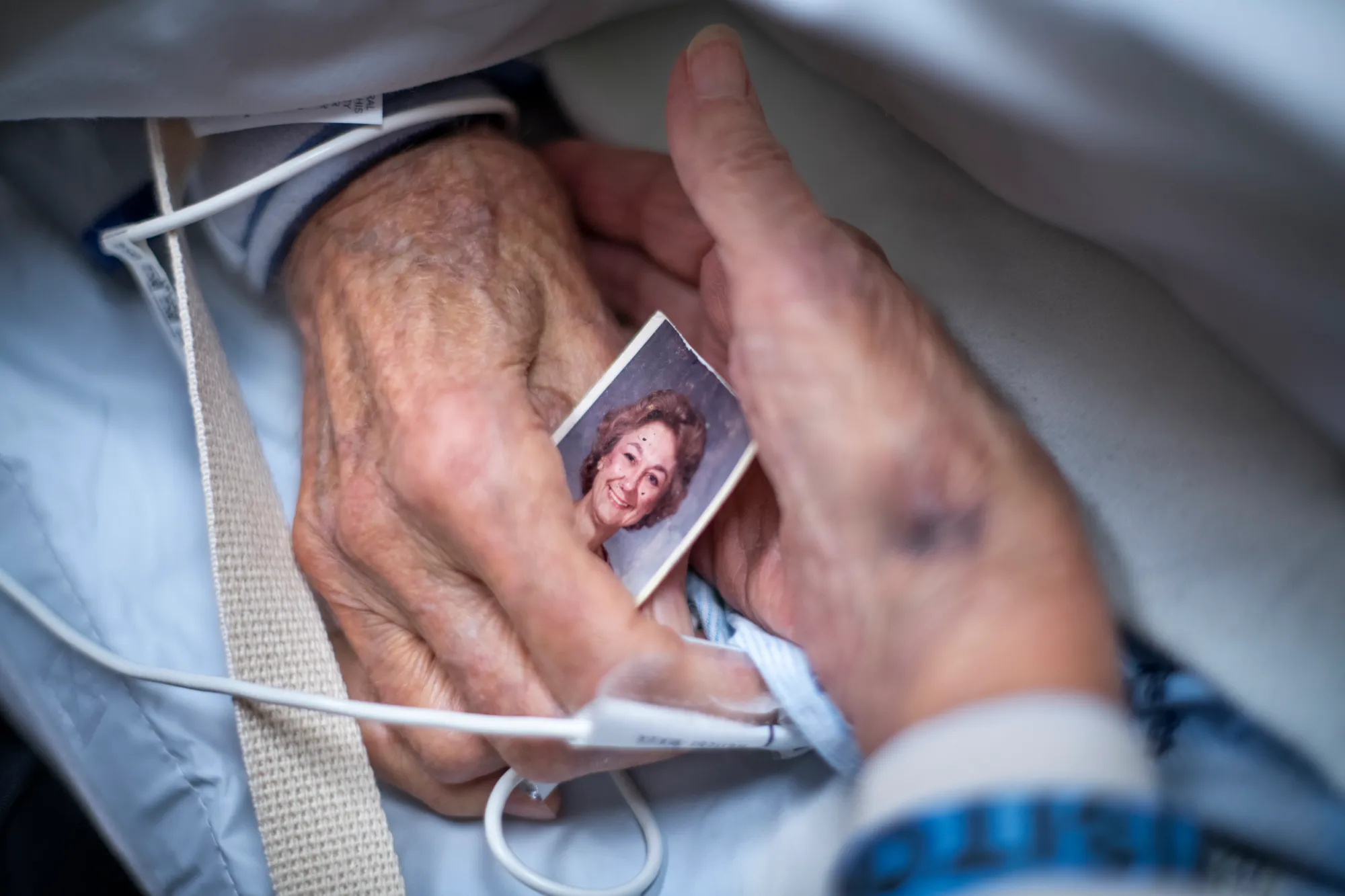
Is there a question you wish I’d asked that I didn’t? If so, what is it, and what’s its answer?
“I can think of one. What image did you not take that you wished you had? I did not take any photographs of myself with my parents that year. I am always holding the camera and never really thought to place myself with them in the frame. I don’t even have a phone photo of myself with them. While I recognize my presence behind the camera, I will wish for that smiling face photo with them.”
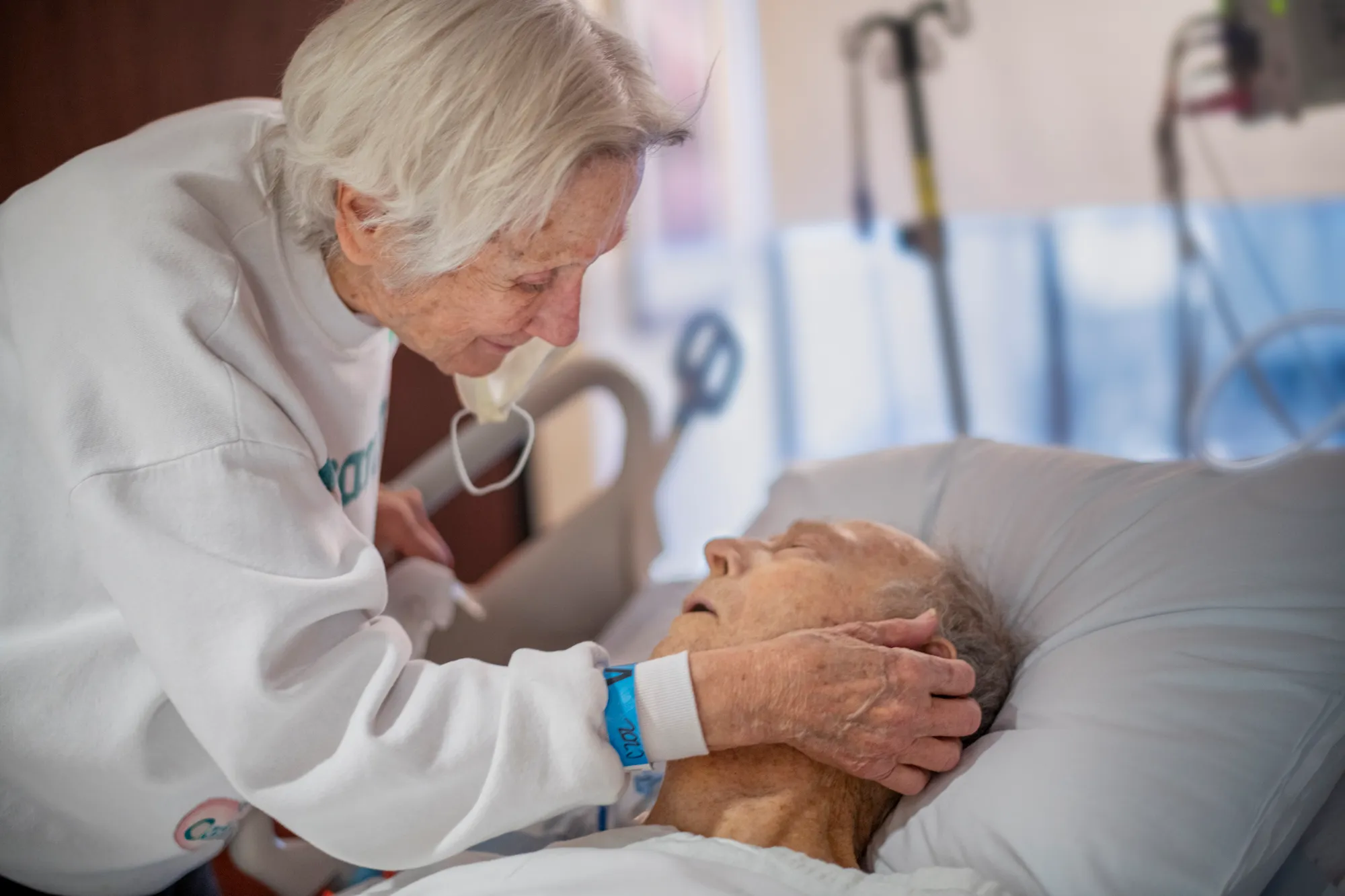
All images © Becky Wilkes. Becky Wilkes is a Top 50 finalist for Photolucida’s Critical Mass.



Leave a Reply